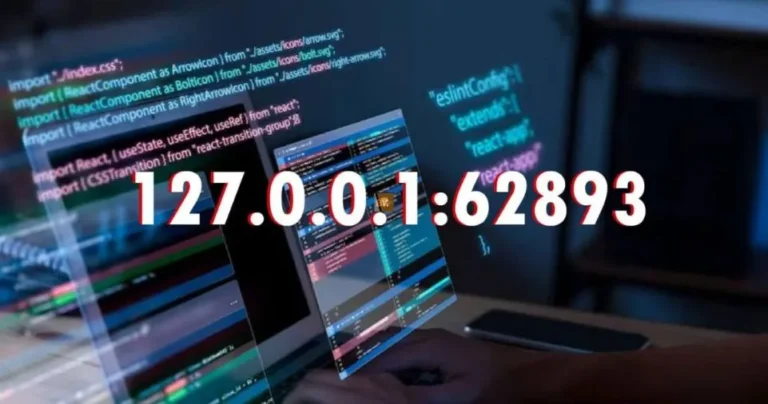You might have come across the code “127.0.0.1:62893” while troubleshooting or configuring your computer and felt confused.
What is this string of numbers, and why is it important? Don’t worry, you’re not alone. This code is more straightforward than it seems, and understanding it will give you deeper insight into how your computer works.
In this article, we will break down what 127.0.0.1:62893 means, how it functions, and what role it plays in your computer’s internal communications.
We’ll also explore why this address appears and offer tips to ensure your system remains secure.
What is 127.0.0.1:62893?
To understand this code, let’s dissect it into two distinct parts: 127.0.0.1 and 62893.
127.0.0.1 – Your Computer’s Localhost
The IP address 127.0.0.1 is known as localhost. Think of it as your computer’s internal communication system.
Every device connected to a network has a unique IP address, which allows other devices to identify and communicate with it. However, localhost is special because it always points back to your own computer.
In simpler terms, localhost acts like your house’s secret back door. Instead of opening the main door for others, this door lets different parts of your computer talk to each other.
For instance, when an application on your device needs to send or receive data without leaving your computer, it uses localhost.
62893 – The Port Number
The second part, 62893, is called a port number. Ports are like doorways that let specific types of data flow in and out of your computer.
Each port is dedicated to a particular service or application. In this case, port 62893 is less common but might be used by certain software programs such as Memcached, which stores temporary data to improve performance.
When you see 127.0.0.1:62893, your computer is directing traffic to a specific service running on that port.
Why Does 127.0.0.1:62893 Appear?

You may encounter this code in a few common situations. Let’s break down when and why it appears.
Error Messages
If a program on your computer encounters issues connecting to localhost or communicating through port 62893, an error message containing this code might pop up.
This usually signals a problem with internal communication between programs on your machine.
Development and Testing
Developers often use localhost to test applications in a safe, isolated environment. When building software that involves servers, they use 127.0.0.1 to simulate real-world network connections.
The 62893 port might be used for services like Memcached during testing to store temporary data.
Software Configuration
In some cases, configuring specific software might require you to enter a localhost address and port number.
This is common in applications that need internal communication or caching services like Memcached.
Is 127.0.0.1:62893 Safe?
In most situations, encountering 127.0.0.1:62893 is perfectly normal and doesn’t present a security risk.
It simply indicates your computer is communicating internally, possibly running a service or program that requires it.
Tips for Security:
- Verify the Source: If you see 127.0.0.1:62893 in an unexpected program or window, confirm its origin. Trusted programs shouldn’t act suspiciously.
- Run a Malware Scan: If you’re worried about malware using localhost for malicious purposes, consider running a scan with your antivirus software to ensure your system is safe.
- Consult a Professional: If you’re unsure about a specific program or service using this address, it’s always a good idea to ask a tech-savvy friend or consult a professional for advice.
How Computers Use Localhost and Ports
To understand 127.0.0.1:62893 more deeply, it’s essential to know a bit more about how computers use localhost and ports to communicate.
IP Addresses
Each device connected to the internet or a local network has its own unique IP address. These addresses allow devices to locate and communicate with each other.
However, when a computer uses localhost (127.0.0.1), it is talking to itself, allowing programs running on the same machine to exchange information.
Ports
Think of ports like different doors that control data entering or leaving your computer. Specific ports are assigned to particular services, ensuring that the right information gets to the right place.
For example, port 80 is typically used for web traffic, while other ports, like 62893, may be reserved for less common services like Memcached.
The Client-Server Model
Many programs operate using the client-server model. In this system, a client (like your web browser) requests data from a server (like a website).
Localhost helps simulate this model internally, especially for developers who need to test software without exposing it to the internet.
Troubleshooting 127.0.0.1:62893 Issues

While seeing 127.0.0.1:62893 is usually harmless, occasional problems can arise. Here are some steps to troubleshoot if you encounter issues:
Restart the Program
Many issues can be resolved by simply restarting the program. This action clears temporary glitches that might have caused the problem.
Check Firewall Settings
Sometimes, your firewall could block communication through port 62893. If you suspect this is the case, review your firewall settings and make sure it’s not restricting access to the program in question.
Review Software Configuration
If you’re configuring software that uses localhost and port numbers, double-check the settings to ensure everything is correct. Refer to the program’s documentation to resolve any configuration issues.
Update the Software
Outdated software may cause compatibility problems with certain ports or services. Ensure your software is up to date by installing the latest patches or updates provided by the developer.
Disable Memcached (if applicable)
If you suspect that Memcached (or another service using port 62893) is causing issues, you can try disabling it.
However, proceed cautiously—disabling system services without proper knowledge could lead to other problems. Seek advice if you’re unsure.
Beyond Localhost: Understanding Network Communication
Understanding 127.0.0.1:62893 is just the beginning. Here are a few other related concepts to help you grasp the bigger picture of network communication:
1. External IP Addresses
Unlike localhost, external IP addresses are used to communicate with devices outside your computer.
When you visit a website, your computer communicates with the website’s server using external IP addresses.
2. Common Ports
While port 62893 might be less familiar, certain ports, like 80 (used for HTTP) and 443 (used for HTTPS), are crucial for web browsing. Understanding common ports will help you troubleshoot issues more effectively.
3. Client-Server Communication
Most applications and websites rely on the client-server model, where the client requests information, and the server delivers it.
By simulating this process with localhost, developers can test how their software handles real-world conditions without putting it online.
ALSO READ
Conclusion
By now, you should have a solid understanding of 127.0.0.1:62893 and its role in your computer’s internal operations.
It’s simply a combination of localhost (internal communication) and a port number (used by a specific service).
While most users won’t encounter this code frequently, knowing what it means can help you troubleshoot issues or interpret software configurations.
Whether you’re a casual user or someone interested in learning more about networking, grasping the fundamentals of localhost and ports will give you a better understanding of how computers communicate internally and over networks.
For those looking to dive deeper, consider exploring more about IP addresses, port numbers, and the client-server model.
This knowledge will equip you to troubleshoot networking issues and understand the inner workings of your computer with greater confidence.

